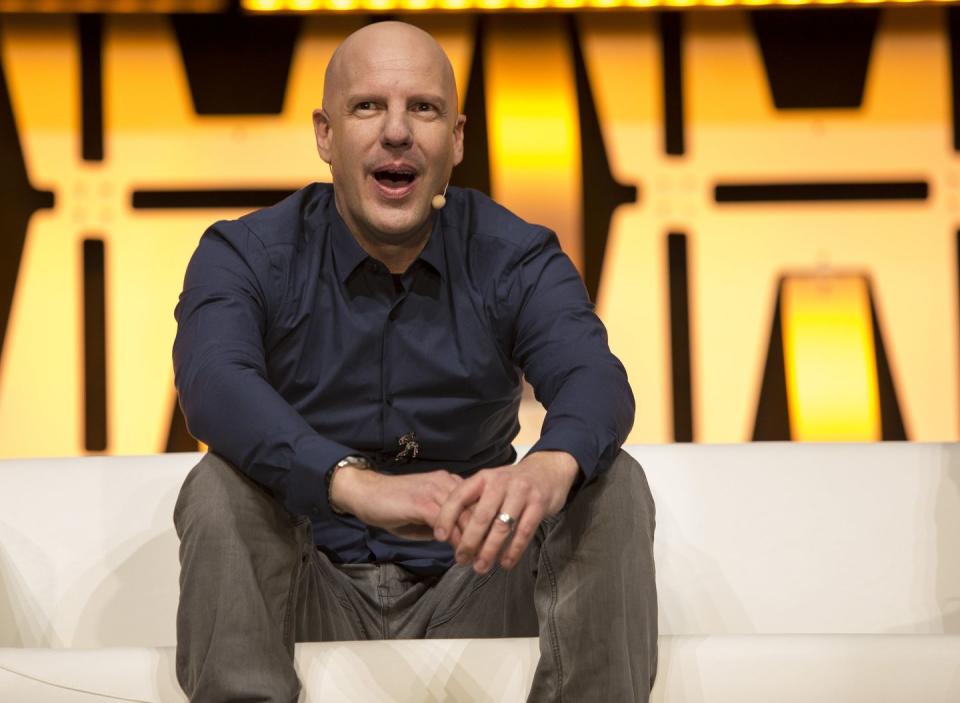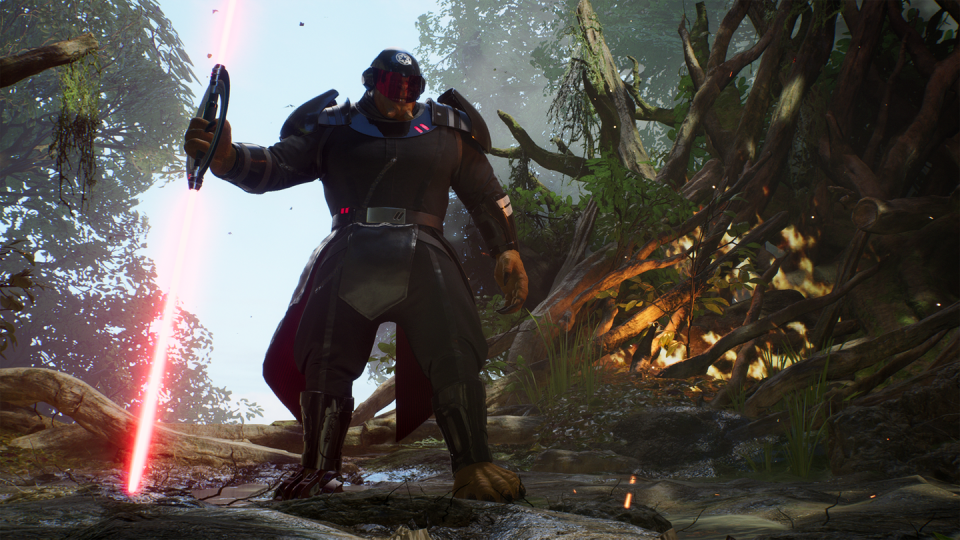You've Never Experienced Lightsaber Combat Like That in 'Star Wars Jedi: Fallen Order'
A lightsaber is a one-hit killing machine. Stig Asmussen, the director of Star Wars Jedi: Fallen Order, reminded me of that when I asked him how his team at Respawn Entertainment was able to make their ambitious new Star Wars game feel so distinctive. "We had to create these systems that would force the player to unlock the enemy to allow for that one hit kill," Asmussen said. Instead of mindlessly cutting through waves of enemies, the gameplay in Fallen Order is full of lightsaber-enhanced grappling bouts. You're forced to take on one opponent at a time—and these strategic little duels can even extend into entire boss battles. It’s what he refers to as "thoughtful combat."
Respawn’s dedication to creating brutal, yet intuitive lightsaber combat makes Fallen Order among the most promising Star Wars games in years. Lightsaber blades are devastating in Fallen Order. Cutting through the obstacles and enemies of the game’s exotic planets, there is a sense of real danger surrounding these glowing swords. But while the combat gameplay is loud and chaotic, it’s also refreshingly minimal, initially centered around just two buttons: attack and block/parry. It’s such a simple, well-built system that I barely needed a tutorial before firing up the campaign.

In George Lucas’s original Star Wars film trilogy, lightsabers are unstoppable weapons to behold. They’re heavy, crackling with power, and in the hands of the wrong individual, they seem treacherous. Even the most casual Star Wars fans can recall the anguish in Luke Skywalker’s face after Darth Vader eviscerates the young Jedi’s hand clean off the bone with his sizzling red lightsaber. It’s moments like this that make lightsabers among the most memorable—and crushing—weapons in film history.
Video games have long tried to bottle up the phenomenon of the lightsaber. THQ’s Jedi Power Battles from 2000 offered a zany, arcade approach to lightsaber dueling. The combat, however, more closely resembled the hyper-powered nonsense of Lucas’s prequel trilogy than the series’ more samurai-inspired origins. Games like The Force Unleashed and Knights of the Old Republic immersed players in narratively rich swordsman tales with boundless Jedi abilities. You could obliterate the playing field in Force Unleashed, and waggling around multiple yellow lightsabers in Old Republic was fun.
But Lucas’s franchise has always been known for its down-to-earth, introspective feeling. And Fallen Order is the first Star Wars game to really investigate the humanity behind the whirring laser swords. Unlike the lead players of previous Star Wars games such as Shadow of the Empire's Dash Rendar or Jedi Knight's Kyle Katarn, its protagonist Cal Kestis doesn't move like a rigid block of polygons. His neck bounces when he runs. He's emotive. When he ignites his lightsaber, his hand jolts at the impact. You can feel the influence of strikingly human games like Last of Us and God of War here.
Time will tell if Fallen Order will fulfill the lofty expectations of the ever-demanding Star Wars fanbase. But whether the game succeeds or not, one thing seems clear after I spent a few hours in the main campaign: The lightsaber combat in Fallen Order is absolutely killer. I sat down with Asmussen to talk about how Respawn put together a fighting style that makes their upcoming title feel more nuanced and singular in gameplay than any Star Wars game before it.
Esquire: We’ve always wanted a Star Wars game with good lightsaber combat. The combat system in Fallen Order seems simple and to the point. How did your team go about crafting it?
Stig Asmussen: First, we wanted it to feel grounded. And we wanted it to be something that reflected the journey that the hero is going on, which is also the journey that the player is going on as well. You’re a student. You’re learning. You don’t know how to do everything at first, but over the course of the game, your skillset grows, and the student eventually becomes a master. Really, it comes down to: If it’s going to be grounded, it’s not the amount of moves, it’s how you use the moves you have and how they are used as a response to the enemies, how you’re evaluating your timing windows and planning your attacks.
ESQ: Was one of the main initiatives of Fallen Order to make a game that perfected lightsaber combat?
SA: Outside of crafting a real Star Wars story, that’s right up there. We needed to have what we called "thoughtful combat." We wanted the player to, just like a Jedi, be patient. To walk into a situation and analyze things and think, "What’s the best approach?" One of the early things that we had to crack was: How do we make a fight like this feel compelling, knowing that the lightsaber is basically a weapon that will, one hit, kill your enemy? So, we had to create these systems that would force the player to unlock the enemy to allow for that one hit kill. That’s why we brought things in like block meters, that’s why we allowed the player to reflect blaster bolts from ranged enemies—but also if you time it correctly, send the bolt back at them.
Then what it becomes is each enemy unit has their own purpose. And when you start to put them together in different combinations, then the player really has to think. They have to be very honest in how they are responding to the different enemies’ positions and what their roles are.
ESQ: Were there any Star Wars games that your team took inspiration from?
SA: We looked at as many as we could. I think there was a sale on Steam. Very early on, you could get, like, every single Star Wars game for twenty bucks. We had played these games before, growing up, but we stopped for a week and really started looking at the old Jedi Knight games, even looking at a game like Knights of the Old Republic, because I think they really nailed story. They nailed atmosphere. So yeah, we look at those games and pulled what was working from them and tried to help that influence the work that we were doing.

ESQ: Were there games outside of Star Wars that were an influence?
SA: Yeah. Countless games.
ESQ: You worked on the God of War series.
SA: Yeah, I worked on God of War 1 through God of War 3, and obviously that made an influence on me, not only on a design standpoint, but from a production and "how you make games" approach—the standard for where your bar is, what kind of quality, that kind of thing. But, to be honest with you, I’d be lying to you if I didn’t say Star Wars influenced the work that I did on God of War games and other games that I’ve worked on. So, it’s funny that it goes full circle.
When we’re creating different mechanics for the game, you look at countless other games and we say, "Hey, we need to get this certain feature of this mechanic stood up, here’s an example of something in another game. That should be what we’re striving to get to. And then, once we get there, how do we evolve it and make it our own?" We did that across the board. And I’m a strong believer in rapid prototyping, and rather than just noodling in on one aspect and getting it just right, trying to work horizontally and trying to get a lot of things working at once, so we can assess how they all work together, and then building them up from there. Finding the synergy between them.
ESQ: You've mentioned something about the combination of the fun and the drama, that it creates the Star Wars magic. What is that secret ingredient that makes a Star Wars story?
SA: You know what? I don’t know yet. I’ve learned a lot from working with Lucasfilm, and the team has as well. I think there’s just something that feels right. It’s like, "Oh! We’ve got it!" But I don’t know that there’s a formula that I’ve put together on my end that’s like, "Add this, a dash of that, and you get Star Wars." It’s more of a feel thing.
This interview has been edited and condensed for clarity.
You Might Also Like

